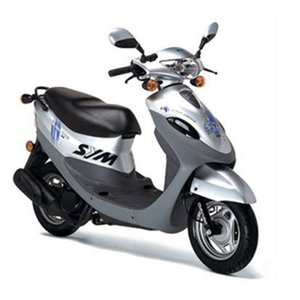SYM DD 50 (2003-2007): A Nimble Urban Companion That Stands the Test of Time
Introduction
The SYM DD 50 is a pint-sized legend in the world of urban scooters. Produced between 2003 and 2007, this Taiwanese two-stroke machine carved its niche as a reliable, no-frills commuter for riders who value simplicity and agility. While 50cc scooters often get dismissed as "beginner bikes," the DD 50 proves that small displacement doesn’t equate to insignificance. After spending a week zipping through city streets and suburban lanes on a well-preserved 2006 model, I’m convinced this scooter deserves more credit than it gets. Let’s dive into what makes this generation of the DD 50 tick – and why it might still be a smart choice for today’s riders.
Design & Ergonomics
Compact Dimensions, Big Practicality
At first glance, the SYM DD 50 looks like every other 2000s-era scooter – and that’s not a bad thing. Its 1,660 mm (65.4 inches) length and 630 mm (24.8 inches) width make it exceptionally lane-friendly, while the 1,020 mm (40.2 inches) height ensures decent wind protection from its minimalist fairing. The 80 kg (176 lb) dry weight feels almost laughably light when pushing it off the stand, a blessing for shorter riders or those navigating tight parking spots.
Rider Triangle
The flat seat sits at a accessible height – likely around 750 mm (29.5 inches) based on proportions – letting most riders plant both feet firmly. Handlebars fall naturally to hand, with controls spaced for glove-friendly operation. The floorboard offers decent legroom for its class, though taller riders might feel cramped on longer rides.
Storage & Practical Touches
SYM nailed the essentials:
- Underseat storage fits a full-face helmet (barely)
- Hook-mounted grocery bags stay secure
- Analog dash with fuel gauge and basic indicators
- Chrome accents that age better than expected
The color options (Black, Red, Silver) look conservative by today’s standards but hide scratches well – a plus for urban warriors.
Engine & Performance
The Heart of the Matter
Don’t let the 49.9cc displacement fool you – this air-cooled two-stroke packs character. The single-cylinder engine delivers 2.8 PS (2.1 kW), peaking around 6,500 RPM. Top speed? A governed 50 km/h (31 mph) where restricted, but derestricted models can nudge 65 km/h (40 mph).
Two-Stroke Charm (and Quirks)
Cold starts require patience – the dual electric/kick starter helps – but once warm, the DD 50 zips off the line with that classic two-stroke buzz. Power delivery is abrupt compared to four-strokes, demanding careful throttle control in wet conditions. The automatic CVT transmission eliminates gear shifts, perfect for stop-and-go traffic.
Fuel & Lubrication
- Pre-mix 2-stroke oil with petrol (1.2L oil tank capacity)
- 6.1L (1.61 US gal) fuel tank gives ~200 km (124 mi) range
- Expect 30-35 km/L (70-82 mpg) depending on riding style
The engine’s simplicity is a double-edged sword: easy to maintain but less refined than modern four-strokes.
Riding Experience
Urban Agility
Where the DD 50 shines is city navigation. The 1,155 mm (45.5 in) wheelbase lets it U-turn on a dime, while the 95 mm (3.7 in) suspension travel soaks up potholes better than expected. Filtering through traffic feels instinctive, aided by mirrors that actually show what’s behind you.
Highway? Not Quite
This isn’t a highway machine – wind blast becomes taxing above 55 km/h (34 mph), and the 10-inch wheels feel skittish over expansion joints. Stick to urban/suburban routes, and the DD 50 is in its element.
Braking Performance
The front disc/rear drum combo works adequately for the scooter’s weight. Brake feel is wooden by modern standards, requiring firm lever pulls. ABS? Forget it – but the light curb weight makes threshold braking manageable with practice.
Competition
How It Stacks Up
In the mid-2000s 50cc scooter wars, the DD 50 faced stiff competition:
- Honda Vision 50
- Four-stroke engine (smoother, but slower acceleration)
- Better fuel economy
-
Higher parts prices
-
Yamaha Aerox 50
- Sportier design
- Liquid-cooled engine
-
More complex maintenance
-
Peugeot Speedfight 50
- Aggressive styling
- French electrical quirks
- Rare outside Europe
SYM’s Edge
The DD 50 wins on simplicity and repair costs. Its steel frame outlasts some rivals’ cheaper alloys, while the lack of liquid cooling reduces failure points. For riders wanting a “set it and forget it” commuter, SYM’s offering still makes sense.
Maintenance
Ownership Costs
Here’s where the DD 50 truly shines – if you stay proactive:
-
Spark Plugs
Stock NGK BR8HSA (standard) or BR8HIX (iridium)
Replace every 3,000 km (1,864 mi), gap to 0.6 mm (0.024 in) -
2-Stroke Oil
Use JASO-FD certified oil at 1:50 mix ratio
Clean oil tank screen annually -
Transmission
Change final drive oil (85W-90) every 5,000 km (3,107 mi)
Check CVT belt wear at 10,000 km (6,214 mi) -
Tires
Maintain 1.5 bar (22 psi) front / 2.25 bar (33 psi) rear
Upgrade to modern rubber for better wet grip
Common Issues
- Exhaust carbon buildup (decoke every 15,000 km)
- Sticky carburetors from ethanol fuel (install inline filter)
- Fading side plastics (UV protectant recommended)
MOTOPARTS.store Recommendations
- Upgrade to iridium spark plugs for colder starts
- Install a performance air filter for smoother revving
- Swap brake pads for sintered compounds
- Add a rear cargo rack for practicality
Conclusion
The SYM DD 50 isn’t about cutting-edge tech or eye-watering performance – it’s about honest transportation. Sixteen years after production ended, these scooters still populate city streets worldwide, a testament to their durability. While newer four-strokes may be cleaner and faster, the DD 50 offers a raw, engaging ride that’s becoming rare in today’s sanitized urban mobility landscape.
For riders wanting an affordable, hackable platform or a vintage-adjacent daily rider, the DD 50 remains relevant. Just keep the 2-stroke oil topped up, respect its limitations, and enjoy the buzzing simplicity of an era when scooters were still allowed to have character.



















